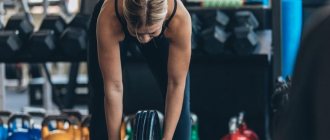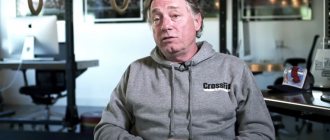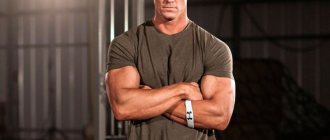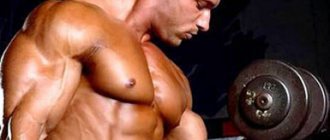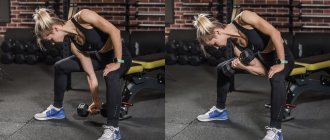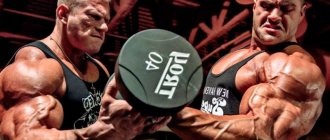These hours can be accumulated at level 1 or 2 within the last 5 years. The Certified Trainer exam consists of a 160-question, multiple-choice test. Each candidate has 3 hours 55 minutes to complete the test. During the testing process, photo and video materials are used with questions that allow you to assess your practical, theoretical skills and knowledge. This exam is administered on a computer at Pearson VUE testing centers around the world.
Crossfit Certification
Tell us more about this original CrossFit certification. How does it go? How many levels are there in total?
There are 4 levels in total. Crossfit founder Greg Glassman, the inventor of this type of training, is interested in offering people a quality product. A few years ago, Crossfit created a separate headquarters of people who conduct seminars for trainers around the world.
Seminars for obtaining Level 1 mainly include introduction to the main 9 CrossFit movements and their development.
Level 2 is more work with a group, aimed at making the coach feel free with a certain number of people, showing and setting the correct technique, suggesting, encouraging, supporting, and being present. Preparation at the first two levels takes 2 days, trainers are trained in groups of 20 to 40 people, there is both theory and practice - I studied some part and immediately practiced in a group.
Level 3 is preparation of a more serious nature: there is a lot of theoretical part and an exam, which consists of 160 questions, here more theoretical knowledge is tested.
And as far as I know, level 4 trainers do not yet exist in Russia; they have even more serious training and exams.
Are everyone admitted to the first levels of certification and everyone is given a certificate at the end?
At the end of Level 1, you are asked to take a test: if it so happens that you did not pass this test, then the entire amount that you paid will not be returned to you. You'll have to retake it again.
How much does certification cost?
The amount for Level 1 and Level 2 is standard, it has not changed for many years, and does not vary from region to region - $1000.
CrossFit: Greg Glassman's Workout Guide
If you're not already familiar with Greg Glassman's training method, then you're probably not keeping up with the latest trends in fitness and sports. Greg Glassman, the founder of such a sports direction as CrossFit, was able to revolutionize approaches to training and attitudes towards sports in the United States and around the world.
Greg began his career as a regular coach at the age of 18 and, after 26 years of work, was able to form his own view of how a person should train in order to get maximum effect in all possible sports skills. At the age of 44 (in 2000), Greg Glassman founded a company that, as of 2022, has more than 14,000 affiliated fitness gyms alone, and that’s 2.7 billion rubles a year in license sales alone, not to mention contracts with Reebok. and other sponsors. Today, CrossFit is not just a training system, it is a community of like-minded people united by a common philosophy, and a full-fledged competitive sport.
What is the secret of such success? We believe this success is due to the fact that CrossFit is one of the few sports disciplines that is based on the scientific method. Everything you ever wanted to know about CrossFit, and why Greg Glassman's method has endeared him to athletes around the world, is covered in detail in his Level 1 Coach Training Guide.
Greg Glassman spoke in some detail in his articles about the features of the training process and all the nuances of CrossFit. The work includes not only the basics and technical features of exercises, but also recommendations regarding nutrition. If you want to understand this training method, then you should definitely read this short (125 pages) Guide.
The book consists of the following chapters:
- Understanding CrossFit as a System
- CrossFit Basics
- What is fitness and the new three-dimensional definition of health
- What is threshold training
- Anatomy and physiology for athletes
- Exercise technique Squat technique (Squat)
- Overhead Squat Technique
- Shoulder Press, Push Press and Push Jerk techniques
- Deadlift technique
- Technique: Taking a medicine ball to the chest (Medicine Ball Clean)
- Lifting the body (sit-up) on the Glute-Ham Developer simulator
- Glycemic index of foods
- Squats (Air Squat)
Download Greg Glassman's L1 Workout Guide
New version of the training manual
Quite informative and interesting work for those who want to learn more about sports techniques and increase the effectiveness of training. The guide will definitely appeal to all fans of a healthy lifestyle.
Author: Chernov A.V.
Editor: Chekardina Elizaveta Yurievna
- To write or not to write? - that is the question https://psychosearch.ru/7reasonstowrite
- How to become a partner of PsychoPoisk magazine? https://psychosearch.ru/onas
- Several ways to support PsychoSearch https://psychosearch.ru/donate
| If you notice an error or typo in the text, highlight it with the cursor and press Ctrl + Enter | Didn't like the article? Write to us why, and we will try to make our materials better! |
Crossfit and children
Can children do CrossFit? And from what age?
Yes, in general, children's CrossFit is not like adult CrossFit; no one loads children with barbells and forces them to row for hours. Here the main emphasis is on variability and games.
Crossfit Terraleon has two groups - for older children (11-16 years old) and younger ones (7-11 years old). In my opinion, there is no point in sending a child to CrossFit from the age of 4, like figure skating. Children can approach some exercises from CrossFit itself a little later, if the child is 6-7 years old, for starters it’s just technical training with a stick or more running.
Older guys are already studying technical aspects and complex exercises in depth: for example, walking on hands, jerks, and pushes. Of course, all this is scaled in terms of weight and intensity for children.
There is also a separate course for children's CrossFit trainers. And we (from the Crossfit Terraleon club) are now sending our friendliest coach so that he learns all the intricacies of working with children and our children's CrossFit section becomes the best.
About the club
Tell us more about Terraleon , how spacious is it and what equipment does it have?
We are very ambitious - we have and will continue to have the task of making the best club, with the most competent coaches, with the best equipment and conditions. And equipment is one of the main aspects. Therefore, we decided to go the proven way, we use special equipment for CrossFit from the American company Rogue - it is completely indestructible.
Alexandra is proud of her club's equipment.
Our rowing and skiing machines from Concept are world leaders in their field. We even have a special person who monitors the equipment and inventory so that it is in proper condition: lubricated and serviced on time.
Terraleon is very spacious - the total area is 600 square meters. m. is quite a lot. The main problem of crossfit gyms not only in St. Petersburg, but throughout the world is the small space for work, which cannot accommodate a large number of people and equipment. We're doing great with this.
What kind of people go to CrossFit?
Ordinary ordinary people you meet on the subway. These are not jocks; usually visitors do not set sporting or competitive goals and practice for fun.
Now there are many girls (approximately 30-40% of the total number of visitors) who, after devoting some time to raising their children, want to get back into good physical shape. There are adults over 40, there are young ambitious guys who want to achieve success not only in the field of CrossFit, but also in other sports.
How do you arrange payment?
We have a fairly flexible system. Everyone has different goals and different levels of preparation.
If you have never done CrossFit before, then we have a group for beginners, you need to go through a cycle of 12 classes.
Because if you immediately come to the main group and get into a complex complex, the desire to do CrossFit may disappear.
Yes, it always works.
Official website of the Terraleon club.
Crossfit level 1 Trainer (CF-L1)
The CrossFit Level 1 course contains only the most basic (initial) information on the fundamental movements and principles used in CrossFit training, the main goal of which is:
Before starting training, it is advisable to study the CrossFit Level 1 Training Guide since it is in Russian. At the end of the course, you will be required to take a 55-question, multiple-choice test.
Having successfully passed the test, you will be issued a trainer certificate valid for 5 years. The price of the course at the time of writing this article is $1000. After the certificate expires, you must take a written test and most likely pay again.
In Russia, such courses are conducted mainly in Moscow and St. Petersburg and somewhere else in Siberia
Training in Terraleon
Alexandra, tell us how you train at CrossFit Terraleon? Are these only scheduled group classes or are there different options?
Conventionally, we can divide training into 4 formats:
- General group training . Class sizes vary, but even 2 people are also group training. In our hall it is comfortable to train up to 20-30 people. The trainer works in the process with the group as a whole and with each individual for an hour.
- Group sections: rowing, running, artistic gymnastics and weightlifting.
- Individual training . Each trainer can optionally conduct individual training one-on-one or in micro-groups.
Group classes for beginners to get acquainted with the exercises and prepare for more serious loads. There is a slightly reduced load, more emphasis on technique in order to prepare the person’s body so that he can subsequently perform basic movements with the correct technique.
What does the training itself look like? Do you need to do a certain set of speed exercises in a circle?
If you look at the entire workout as a whole, it usually takes an hour and a half. During this hour, it is imperative to go through a certain sequence, which begins with a dynamic warm-up of the joints. Next we discuss the complex, the task that will need to be completed during training. Then the coach always checks that everyone understands what is being said and knows how to do it. Then there is a short preparation and, in fact, then comes the complex of the day itself. And after that, cool down, work on the abs or stretch. Something that will bring the body back to earth.
As for the complexes themselves, there are a lot of different schemes that allow you not to get bored during training. We take some exercises from gymnastics, weightlifting, and circuit sports and mix them in incredible combinations “to prepare for the unknown,” as Greg Glassman says.
Accordingly, there is variability in key aspects: we can perform a certain number of movements over a period of time and strive to complete as many rounds as possible in a fixed time. Or vice versa - do a fixed number of rounds in the shortest possible time.
There are monostructural loads, when during a workout we perform one exercise, for example, rowing for maximum calories or meter.
Litgu.ru - Literary Guru
Name:
CrossFit: Training Guide
Author:
Greg Glassman
Publisher:
Cross.expert
Year:
2019
Format:
pdf
Pages:
125
Size:
30 mb
Language:
Russian The CrossFit Training Guide is a collection of articles from CrossFit magazine, written over the past 10 years, primarily by the founder of CrossFit Greg Glassman and discusses the fundamental movements and ideas that make up the CrossFit methodology. This Guide is designed to be used in conjunction with our CrossFit Level 1 Trainer Preparation Course to help you prepare for the CrossFit Level 1 Trainer Certification Test. This is a necessary but not exhaustive source. Some of the information needed to take the test is contained in these articles; everything else is taught directly during the two-day training. The information contained in these articles is fundamental to the CrossFit methodology and, like CrossFit magazine as a whole, should help you create a successful training process.
CrossFit Level 1 Understanding CrossFit Basics What is Fitness? The New 3D Definition of Fitness and Health CrossFit Technique At the Blackboard: Threshold Training. Movements Anatomy and Physiology for Athletes Squat Clinic Overhead Squat Shoulder Press, Push Press, Push Jerk Deadlift Medicine Ball Clean Chest (Medicine Ball Clean) Glute-Ham Developer Sit-Up Nutrition Food Glycemic Index Menu Examples Nutrition Lecture: Disease Prevention Nutrition Lecture: Performance Optimization Diet, Inflammation and Disease (Fish Oil) Program Design and Scaling CrossFit Girls Program Theoretical Template for Grandmothers Coaching and Training Fundamentals, Virtuosity and Mastery Killer Workouts The Truth About Rhabdomyolysis Training, Tracking and Fixing 9 Moves Introduction Air Squat. Front Squat Overhead Squat Shoulder Press Push Press Push Jerk Deadlift Sumo Deadlift High Pull Medicine Ball Clean Crossfit Level 1 Trainer License Agreement in Plain Language Member Handbook Overview Version 7.2
CrossFit and injury risk
It's no secret that CrossFit is accused of causing injuries. Tell me, in your opinion, how dangerous is CrossFit? Do you do any testing for beginners before allowing them to try more complex exercises?
CrossFit is indeed often accused of being an injury-prone sport, because in addition to the fact that it includes quite difficult exercises, there is also a competitive aspect when you try to do it faster than everyone else - and this leads to all sorts of unpleasant consequences.
Therefore, it is very important to work through these topics with beginners. At the forefront of everything is perfect technique and only after that can you add a little speed and intensity, and only then can you add weight
Progress follows clearly in this sequence.
In general, the coach is always with the group, watching, investing as much as possible in conveying the correct technique in different ways: verbally, tactilely, visually. Accordingly, an athlete who is interested in his body serving him long and well makes certain conscious efforts on his part. This greatly reduces injuries.
You may need to tweak your technique or learn new movements in general.
CrossFit includes many movements that need to be carefully studied and mastered gradually. For most people, training for Olympic weightlifting lifts on your own is nearly impossible. You need a coach who will set the angles correctly, teach you how to take the correct starting position, lower your hips lower, say “you're doing the lift too early” and explain why you need to work more on shoulder and ankle mobility so that the weight on the bar becomes heavier. You need a good, attentive observer, someone who knows what solution to propose and understands what it is.
The benefits of CrossFit for the body
As with other types of physical activity, the human body and body are significantly transformed. Qualitative changes are observed in the following systems:
- Respiratory. With regular training, shortness of breath disappears, respiratory function stabilizes, and the working volume of the respiratory tract gradually increases. This process leads to an abundant supply of oxygenated blood to all tissues of the human body. Through the respiratory tract, waste products are removed from the body faster. CrossFit trainer, whose training will tell you more about the transformation of the respiratory system .
The benefits of CrossFit for the body
- Cardiovascular. With systematic training, the tone of blood vessels, which include arteries, veins and capillaries, significantly increases. As a result, there is an improvement in overall well-being and increased performance, especially during intense physical activity. Heart pulsation under the same load, after a certain time of training, decreases significantly, a person successfully performs difficult ones and does not get tired. The overall functionality and endurance of the heart muscle increases; in one unit of time it can pump more blood. This allows more nutrient-rich blood to be supplied to the tissues.
Getting the most out of your CrossFit trainer experience
- Digestive. Normalized physical activity helps improve food digestion and stabilizes the functioning of the intestines, where the bulk of the entire immune system is located. The normalization of the load during the training process in a specialized gym is guaranteed by the fact that employees undergo CrossFit trainer courses before going to work in a specialized institution where people do cross-training.
Crossfit courses with a trainer for development
In addition, a person engaged in circular functional training observes the following positive changes:
- Increased performance. It is much easier to bear everyday stress when performing household chores, reduces fatigue, and increases the endurance of muscle tissue.
- Significant changes in appearance. A wide range of exercises aimed at developing various functional characteristics will help increase the volume of muscles in one group, draw relief in another area of the figure, and get rid of excess fat deposits in unwanted areas.
- Mood stabilizes. With regular training, a person begins to feel relaxed, a feeling of satisfaction appears, and persistent stressful situations are eliminated. A CrossFit trainer, for whom Moscow is a “Klondike” for professional activities, will always help you psychologically cope with stress, and regular exercise will accordingly help solve everyday psychological problems.
Alexey Lyubimy, a crossfit trainer, can clarify all the nuances of the benefits of cross-training for the human body.
This material contains an article from the “Complete Guide to CrossFit Training” in Russian, dedicated to programming in CrossFit. The purpose of the article is to identify a model or template for creating a training program that can explain the concept of CrossFit and potentially stimulate productive ideas about the construction of the training process in general and the design of training complexes in particular.
Most CrossFit readers and fans are familiar with the Workout of the Day (WOD) posted on official CrossFit websites and have a clear understanding of how the CrossFit program is implemented. What is less clear is the logic behind the construction of training complexes , or, more specifically, what determines the specifics of programming in CF.
Let us recall that FixBody previously published an article from the official publication The CrossFit Journal “What is CrossFit Fitness,” which discussed in detail the goals and objectives of CrossFit.
So, now let's build a bridge between understanding the philosophy of physical fitness and training as such, that is, between theory and practice.
At first glance, the pattern looks like a rigid training program or regimen. This may seem to contradict our claims that training should contain variety, if not chance, to best suit the unpredictable challenges that the demands of sport, war or survival present us with.
We often say that “ your routine should not become a routine .” However, the model we propose allows for a wide variety of modalities, exercises, metabolic systems, rest, intensities, sets and repetitions.
In fact, it can be said with mathematical precision that each of the three-day cycles contains a unique training stimulus that will never be repeated in CrossFit.
The sample is designed to provide a broad and variable stimulus that varies in some respects but is consistent with CrossFit's goals and objectives. Our sample has the structure necessary to formalize and define programming goals, but does not define the key parameters that must vary in order to meet our goals. Our mission is the perfect blend of structure and flexibility. We're not saying that your workouts have to fit a template or that our workouts fit neatly into one, because that's not the case at all. However, the pattern provides a clear structure that is easy to understand, reflects our programming aspirations, and does not conflict with the need for a constantly varying training stimulus. In other words, this pattern is as much descriptive as it is prescriptive.
General overview of the template
In its most general form, the template is built on 3 days of training and 1 day of rest. We found that this allowed for a relatively larger amount of high-intensity work than other patterns we experimented with. In this format, an athlete can work at near-maximum intensity for three days, but on the fourth day, neuromuscular function and anatomy have been pushed to the point where work is significantly less effective and impossible without reducing intensity.
The main disadvantage of the 3/1 model is that it is not the same as the 5/2 model, which is most suitable to fit into the work schedules of people around the world. This model is inconsistent with a seven-day week. For many of our clients, the demands of work, family or school were more suited to a five-day, one-weekend schedule. Initially, workouts on the site were published using a 5/2 pattern, and this template worked great. However, the 3/1 model was introduced to improve the intensity and effectiveness of recovery, and the feedback and results received have confirmed its success.
If you feel better with the 5/2 model, use it. Differences in the potential of patterns should not be the reason for restructuring your life to a more effective one. There are also other factors that will outweigh the disadvantages of a potentially less effective regimen, such as convenience, attitude, exercise selection, and pacing.
The discussion here is specifically about a three-day cycle, but most of the material fits perfectly into a five-day cycle.
Elements of modalities
The workouts are built from three different modalities: metabolic training (“M”), calisthenics (“G”) and weight training (“W”). Metabolic training is a homogeneous activity, often called "cardio", and the goal of which is to increase cardiovascular performance and endurance. Gymnastics includes body weight exercises as well as elements of calisthenics, and its main purpose is to optimize body control by developing neurological components such as coordination, balance, agility and accuracy, as well as increasing core performance and strength.
The weight lifting modality includes the most important fundamental barbell exercises from weightlifting and powerlifting that aim to develop strength, power and performance in the pelvis and legs.
The elements or exercises for each modality were selected based on their functionality, ability to elicit a neuroendocrine response, and overall ability to benefit the human body.
Structure of the training complex
Training complexes include one, two or three elements per day. Days 1, 5 and 9 include one element; Days 2, 6 and 10 use 2 elements, and days 3, 7 and 11 use three elements. In each case, each modality is represented by one exercise or element, that is, each M, G and W are represented by one exercise from metabolic training, calisthenics and weight lifting, respectively.
When the workout consists of a single exercise (days 1, 5 and 9), the focus is on one exercise or effort. If the element is “M” (day 1), then the training is a single exercise, usually over a long, slow distance. When the modality is single “G” (Day 5), the training is a single skill and usually the skill is quite complex and requires significant practice and is not sufficiently practiced to be included in training routines. On “W” days (Day 9), the workout is built around a single barbell exercise performed with heavy weight and low repetitions. It's worth repeating that the focus on days 1, 5, and 9 is on single attempts at long-distance "cardio", mastery of compound gymnastics movements, and heavy, low-rep work on one of the barbell exercises, respectively. These days do not train sprints, pull-ups or clean and jerks for a large number of repetitions - other days are more suitable for this. On “one element” days (1, 5 and 9), recovery does not play a significant role. On days of gymnastics and weight lifting, rest between sets is chosen based on how you feel, and the focus is on working out the element rather than the overall metabolic effect.
On two element days (2, 6 and 10) , the structure is represented by two exercises performed alternately for 3, 4 or, most often, 5 rounds for time. We say that these days have "task priority" because the task is set and the time may vary. A routine is often measured by the time it takes to complete five rounds. The two elements are selected to provide a moderate to high intensity level, and managing work and rest intervals is critical. These workouts are intense in tempo, weight of weights, number of repetitions, or according to a specific combination. Ideally, the first round is hard but doable, while the second and subsequent rounds require pacing, rest timing, and breaking the task down into bite-sized chunks. If the second round can be completed without problems, the elements are chosen too easily.
For three element days (3, 7 and 11) , the structure is usually three exercises, this time repeated for 20 minutes and scored on the number of rounds completed within twenty minutes. We call these workouts "time priority" routines because the athlete continues to work for a set time and the goal is to complete as many circuits as possible. Ideally, elements are selected in such a way as to provide as many rounds as possible within the specified time. This contrasts with "two element" days, where the elements are performed much more intensely.
These workouts are hard, very hard, but managing the intervals of work and time is not critical. Each of the three different days has a different character. In general, as the number of elements increases from one to three, the training effect adds up less due to the individual element and more due to a sufficient number of repetitions.
Application
The template presented is not used to create workouts on the crossfit.com website, but the use of one, two and three element workouts is due to their effectiveness. Our direct experience in the gym and feedback from our athletes following the Workout of the Day has shown that mixing one-, two-, and three-element workouts is devastating in its effects and unmatched in physical response. The information obtained from your feedback on the Workout of the Day (WOD) made it possible to evaluate and calculate the effect of training complexes, which would be almost impossible without the use of the Internet.
Typically, the most effective CrossFit routines, like works of art, are characterized by structure, symmetry, balance, theme and character.
They involve a certain "choreography" of movement, stemming from a knowledge of the basics of physiological adaptation, as well as a well-developed sense of the limits of human performance, the use of effective elements, experimentation and even luck. We hope this template will help you master this art.
The template provides opportunities to master new elements, produces unique stressors, and trains all three energy systems. This happens within the framework of sets and repetitions of a specific group of exercises that are constantly used in CrossFit and have proven to be effective. We maintain that this template clearly expresses the goals and objectives of CrossFit.
